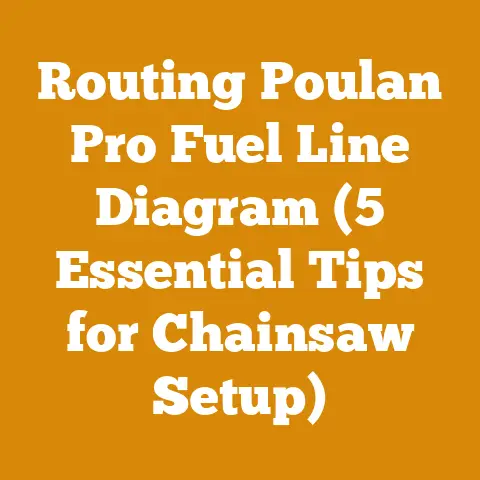Kohler Command Pro 25 Fuel Pump Issues (5 Fixes for Woodcutters)
Let’s delve into the heart of the matter: diagnosing and rectifying fuel pump issues on your Kohler Command Pro 25 engine, a common challenge I’ve faced countless times in my years working with wood. I’ll share my hands-on experience, offering five practical fixes for woodcutters like yourself.
Kohler Command Pro 25 Fuel Pump Issues (5 Fixes for Woodcutters)
From the crisp autumn air of the Adirondacks to the dense forests of the Pacific Northwest, the rhythmic roar of a well-tuned engine has always been the soundtrack of our craft. For generations, woodcutters have relied on these mechanical marvels to power their livelihoods, transforming raw timber into warmth and shelter. The Kohler Command Pro 25 engine, a workhorse in the world of small engine applications, is a familiar sight in many wood processing operations. Like any machine, it can have its quirks, and fuel pump problems are a common gremlin.
Understanding the Kohler Command Pro 25 Fuel System
Before diving into the fixes, it’s important to understand the basics of the Kohler Command Pro 25 fuel system. This engine typically uses a mechanical fuel pump, actuated by the engine’s camshaft. As the engine rotates, a lobe on the camshaft pushes against a lever on the fuel pump, creating a vacuum that draws fuel from the fuel tank, through the fuel filter, and into the carburetor.
This system is simple, but several things can go wrong: a clogged fuel filter, a cracked fuel line, a faulty fuel pump diaphragm, or even a problem with the vacuum pulse.
Symptoms of a Fuel Pump Problem
Identifying the symptoms early can save you time and frustration. Here’s what to look for:
- Engine Stalling: The engine starts and runs for a short time, then stalls. This is often due to fuel starvation.
- Hard Starting: The engine cranks for an extended period before starting, or it may not start at all.
- Loss of Power: The engine runs, but lacks power, especially under load. This indicates that the engine isn’t getting enough fuel.
- Erratic Idling: The engine idles roughly or stalls at idle.
- Fuel Leaks: Obvious fuel leaks around the fuel pump or fuel lines.
Fix #1: Inspect and Replace the Fuel Filter
The fuel filter is the first line of defense against debris entering the fuel system. Over time, it can become clogged with dirt, rust, and other contaminants. A clogged fuel filter restricts fuel flow, leading to the symptoms described above.
My Experience: I once spent an entire afternoon troubleshooting an engine that kept stalling, only to discover a fuel filter so clogged it looked like it was filled with mud. Replacing it solved the problem instantly.
How to Inspect and Replace the Fuel Filter:
- Locate the Fuel Filter: The fuel filter is typically located in the fuel line between the fuel tank and the fuel pump.
- Inspect the Filter: Visually inspect the filter for dirt, debris, or damage. If it looks dirty or clogged, replace it.
- Replace the Filter: Disconnect the fuel lines from the filter, noting the direction of fuel flow (usually indicated by an arrow on the filter). Install a new fuel filter, ensuring it’s facing the correct direction.
- Use the Right Filter: Kohler fuel filter part number 25 050 22-S is a direct replacement. Aftermarket options are available, but ensure they meet Kohler’s specifications for flow rate and filtration.
Tools Needed:
- Pliers (for removing fuel line clamps)
- New fuel filter
Estimated Time: 15-30 minutes
Why This Works: A clean fuel filter ensures a steady flow of fuel to the engine, preventing fuel starvation and improving performance.
Takeaway: Always start with the simplest solution first. A clogged fuel filter is a common problem that’s easy to fix.
Fix #2: Check and Replace Fuel Lines
Fuel lines can crack, harden, or become loose over time, leading to fuel leaks or air leaks. Air leaks can disrupt the fuel pump’s ability to draw fuel from the tank.
How to Check and Replace Fuel Lines:
- Inspect the Fuel Lines: Carefully inspect all fuel lines for cracks, kinks, or signs of wear. Pay close attention to the areas near the fuel pump and carburetor.
- Check for Leaks: With the engine running (if possible), check for fuel leaks around the fuel lines and fittings.
- Replace Damaged Lines: If you find any damaged fuel lines, replace them with new fuel lines of the correct diameter and length. Use fuel-resistant rubber hose specifically designed for small engines.
- Secure the Lines: Secure the fuel lines with clamps to prevent them from coming loose.
Tools Needed:
- Pliers (for removing and installing fuel line clamps)
- Utility knife or hose cutter
- New fuel lines
- Fuel line clamps
Estimated Time: 30-60 minutes
Why This Works: Replacing damaged fuel lines eliminates fuel leaks and air leaks, ensuring a consistent fuel supply to the engine.
Takeaway: Don’t underestimate the importance of fuel lines. Even a small crack can cause big problems.
Fix #3: Test and Rebuild/Replace the Fuel Pump
If the fuel filter and fuel lines are in good condition, the problem may lie with the fuel pump itself. The fuel pump diaphragm can wear out over time, losing its ability to create the necessary vacuum.
My Experience: I once had a fuel pump that looked perfectly fine on the outside, but the diaphragm inside was cracked and brittle. Replacing the pump solved the problem immediately.
How to Test the Fuel Pump:
- Disconnect the Fuel Line: Disconnect the fuel line from the fuel pump to the carburetor.
- Crank the Engine: Crank the engine for a few seconds and see if fuel is being pumped out of the fuel pump.
- Check Fuel Flow: You should see a steady stream of fuel coming from the fuel pump. If there’s no fuel or a weak stream, the fuel pump is likely faulty.
- Vacuum Test: Disconnect the vacuum line from the engine to the fuel pump. With the engine running (or cranking), check for a vacuum pulse. If there is no vacuum pulse, the issue may be with the engine itself, not the fuel pump.
How to Rebuild or Replace the Fuel Pump:
- Rebuild (If Possible): Some fuel pumps can be rebuilt with a new diaphragm and gaskets. Rebuild kits are available for some Kohler engines. Follow the instructions in the rebuild kit carefully.
- Replace the Fuel Pump: If a rebuild kit isn’t available or if the fuel pump is severely damaged, replace it with a new fuel pump.
- Kohler Part Number: The correct Kohler fuel pump part number will vary depending on your specific engine model. Consult your engine’s service manual or Kohler’s website to find the correct part number. A common part number is 24 393 16-S.
- Installation: Install the new or rebuilt fuel pump, connecting the fuel lines and vacuum line securely.
Tools Needed:
- Pliers
- Screwdrivers
- Wrench (for removing and installing the fuel pump)
- Fuel pump rebuild kit (if rebuilding)
- New fuel pump (if replacing)
Estimated Time: 1-2 hours
Why This Works: Replacing a faulty fuel pump restores the engine’s ability to draw fuel from the tank, ensuring a consistent fuel supply to the carburetor.
Takeaway: A faulty fuel pump is a common cause of fuel starvation. Testing the fuel pump is essential to diagnose the problem.
Fix #4: Check the Fuel Tank Vent
The fuel tank vent allows air to enter the fuel tank as fuel is consumed. If the vent is clogged, a vacuum can build up in the tank, preventing the fuel pump from drawing fuel.
My Experience: I had an engine that would run fine for a few minutes, then stall. After checking everything else, I discovered that the fuel tank vent was clogged with dirt. Cleaning the vent solved the problem.
How to Check the Fuel Tank Vent:
- Locate the Vent: The fuel tank vent is usually located on the fuel tank cap or near the top of the fuel tank.
- Inspect the Vent: Check the vent for dirt, debris, or obstructions.
- Clean the Vent: Clean the vent with compressed air or a small wire.
- Test the Vent: With the fuel cap loose, try running the engine. If it runs better, the vent was likely clogged.
Tools Needed:
- Compressed air
- Small wire or pin
Estimated Time: 10-15 minutes
Why This Works: A clear fuel tank vent allows air to enter the tank, preventing a vacuum from building up and ensuring a consistent fuel supply.
Takeaway: Don’t overlook the fuel tank vent. It’s a simple thing that can cause big problems.
Fix #5: Examine the Carburetor
While the fuel pump is often the culprit, issues within the carburetor itself can mimic fuel pump problems. A clogged carburetor jet, a faulty float, or a stuck needle valve can all restrict fuel flow.
My Experience: I once meticulously replaced a fuel pump, only to find the problem persisted. Frustrated, I finally disassembled the carburetor and found a tiny piece of debris blocking the main jet. Cleaning the jet restored the engine to perfect running condition.
How to Examine the Carburetor:
- Visual Inspection: Look for any obvious signs of damage or leaks around the carburetor.
- Carburetor Cleaner: Spray carburetor cleaner into the carburetor throat while the engine is off. This can help loosen any deposits.
- Disassembly and Cleaning: If the problem persists, carefully disassemble the carburetor, paying close attention to the location of all parts. Clean all jets and passages with carburetor cleaner and compressed air.
- Reassembly: Reassemble the carburetor, ensuring all parts are properly seated.
- Float Adjustment: Check the float level and adjust if necessary. Refer to your engine’s service manual for the correct float level specification.
- Needle Valve: Inspect the needle valve for wear or damage. Replace if necessary.
Tools Needed:
- Screwdrivers
- Wrenches
- Carburetor cleaner
- Compressed air
- Small wire or pin (for cleaning jets)
- Carburetor rebuild kit (optional)
Estimated Time: 1-3 hours
Why This Works: A clean and properly adjusted carburetor ensures the correct air-fuel mixture, optimizing engine performance and preventing fuel starvation.
Takeaway: Carburetor problems can often mimic fuel pump problems. Don’t rule out the carburetor as a potential cause.
Preventative Maintenance: The Key to Longevity
Regular preventative maintenance is crucial for keeping your Kohler Command Pro 25 engine running smoothly and avoiding fuel pump problems. Here are some tips:
- Use Fresh Fuel: Use fresh, high-quality gasoline with an octane rating recommended by Kohler. Avoid using fuel that has been stored for more than 30 days.
- Fuel Stabilizer: Add fuel stabilizer to the fuel tank, especially if you’re storing the engine for an extended period. Fuel stabilizer prevents the fuel from breaking down and forming deposits in the fuel system.
- Regular Oil Changes: Change the engine oil and oil filter regularly, following Kohler’s recommended maintenance schedule.
- Air Filter Maintenance: Clean or replace the air filter regularly to prevent dirt and debris from entering the engine.
- Fuel Filter Replacement: Replace the fuel filter at least once a year, or more often if you’re operating in dusty or dirty conditions.
- Inspect Fuel Lines: Regularly inspect the fuel lines for cracks, kinks, or signs of wear.
- Store Properly: Store the engine in a clean, dry place to protect it from the elements.
Real-World Case Studies
Case Study 1: The Stalling Sawmill Engine
A small-scale sawmill operator in Oregon was experiencing intermittent stalling with his Kohler Command Pro 25-powered sawmill. He had already replaced the spark plug and checked the air filter, but the problem persisted. After following my diagnostic steps, he discovered a partially clogged fuel filter. Replacing the filter resolved the stalling issue and restored the sawmill’s productivity.
Case Study 2: The Hard-Starting Log Splitter
A firewood producer in Maine was struggling with a log splitter that was difficult to start. He suspected a fuel pump problem, but wasn’t sure how to diagnose it. I walked him through the fuel pump testing procedure described above. He discovered that the fuel pump wasn’t producing enough fuel flow. Replacing the fuel pump solved the hard-starting problem.
Advanced Troubleshooting Tips
- Check the Vacuum Line: Ensure the vacuum line connecting the engine to the fuel pump is in good condition and properly connected. A loose or cracked vacuum line can prevent the fuel pump from working correctly.
- Inspect the Camshaft Lobe: In rare cases, the camshaft lobe that actuates the fuel pump can wear down, reducing the pump’s stroke. This requires engine disassembly to inspect and repair.
- Fuel Tank Condition: Examine the inside of the fuel tank for rust or debris. A rusty tank can contaminate the fuel system and clog the fuel filter.
- Electrical Issues: Although less common, electrical problems can sometimes mimic fuel pump issues. Check the ignition system and ensure the spark plug is firing correctly.
Safety Precautions
- Work in a Well-Ventilated Area: When working with fuel, always work in a well-ventilated area to avoid inhaling harmful fumes.
- No Smoking: Never smoke or work near open flames when handling fuel.
- Disconnect the Spark Plug: Disconnect the spark plug wire before working on the fuel system to prevent accidental starting.
- Wear Safety Glasses: Wear safety glasses to protect your eyes from fuel splashes.
- Dispose of Fuel Properly: Dispose of used fuel and fuel-soaked rags properly, following local regulations.
Common Mistakes to Avoid
- Ignoring the Fuel Filter: Many people overlook the fuel filter, even though it’s a common cause of fuel pump problems.
- Using the Wrong Fuel Lines: Using fuel lines that aren’t designed for small engines can lead to fuel leaks and other problems.
- Overlooking the Fuel Tank Vent: A clogged fuel tank vent is a simple problem that’s often overlooked.
- Not Testing the Fuel Pump: Replacing the fuel pump without testing it first can waste time and money.
- Forgetting to Use Fuel Stabilizer: Fuel stabilizer is essential for preventing fuel problems, especially when storing the engine for an extended period.
Actionable Metrics for Success
- Fuel Consumption: Monitor fuel consumption to detect changes that may indicate a fuel pump problem.
- Engine Performance: Track engine performance (e.g., RPM, torque) to identify any loss of power.
- Maintenance Schedule: Adhere to a strict maintenance schedule to prevent fuel pump problems and other issues.
- Downtime: Minimize downtime by performing regular preventative maintenance and addressing problems promptly.
The Future of Wood Processing Technology
As technology advances, we’re seeing innovations in engine design and fuel systems that promise to improve efficiency and reliability. Fuel injection systems, for example, are becoming more common in small engines, offering more precise fuel delivery and reduced emissions. Battery-powered equipment is also gaining popularity, offering a quieter and more environmentally friendly alternative to gasoline-powered engines.
Final Thoughts
Troubleshooting fuel pump issues on a Kohler Command Pro 25 engine can be frustrating, but with a systematic approach and a little patience, you can usually identify and fix the problem. Remember to start with the simplest solutions first, and don’t be afraid to seek help from a qualified mechanic if you’re not comfortable working on the engine yourself. I hope that these five fixes have provided you with the knowledge and confidence to tackle fuel pump problems and keep your equipment running smoothly. Now, get back out there and keep that wood moving!






